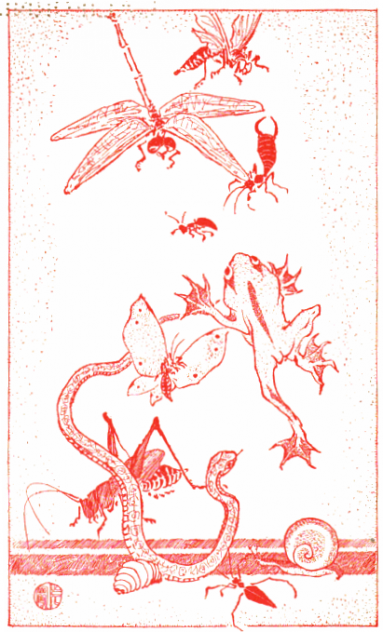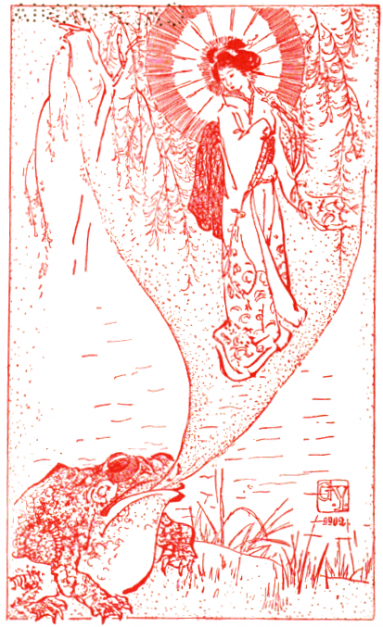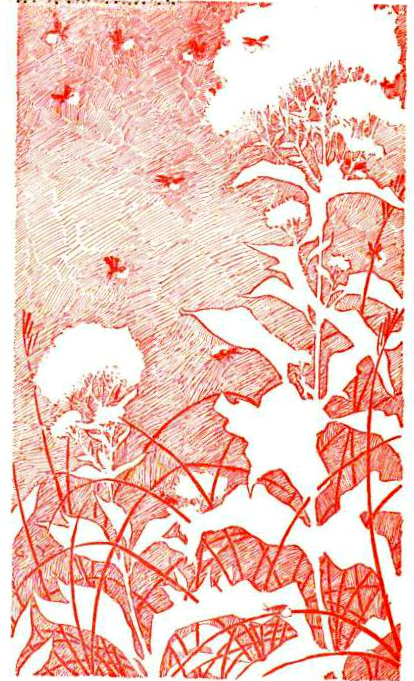Illustrations from Lafcadio Hearn's Kott?: Being Japanese Curios with Sundry Cobwebs (1910)
If seen by day / A firefly / Is just a red-necked bug." -- Bash? (Date unknown)
Of the glimmering swarm gathering at twilight the catcher of fireflies entertained few romantic notions. To him his quarry -- which drew gasps from the crowd gathered at the riverbank, which drew sighs from many a moonstruck poet -- simply meant business.
On summer evenings he began work at dusk, a long bamboo pole hoisted on one shoulder and a bag of brown mosquito netting wound around his waist.
Thus equipped he stumped off for the willows among whose boughs hid his prize. He examined them for the tell-tale glow. The most luminous he struck with his pole. A rain of fireflies followed. Stunned from the blow, they proved easy pickings, their pain making them flare brighter. Before they could recover he scooped them up, popping
Frogs fill their bellies with fireflies until light shines through them like a candle-flame through a porcelain jar.
them in his mouth to save time. Only when his cheeks bulged would he pause to spit them in his net.

The firefly hunter worked into the small hours. Often he caught two, three thousand fireflies, which he would bring the next day to the local firefly broker, who appraised them according to their brilliance: the brighter their bellies, the higher their asking price. The insects usually fetched from three to thirteen sen per hundred.
"I often lingered on the grassy fields, gazing at the fireflies, and thinking of home," writes novelist Shogyo Tamura, recalling in a 1910 issue of The Oriental Economic Review a trip he took to the United States. "But no young friends of mine in America could sympathize with any thoughts of mine about fireflies. The Americans seem to look upon the firefly simply as a subject for scientific research.... When I asked them if they do not think the glow of the firefly might perhaps have some poetic meaning, they replied that the question itself was poetical, and that personally they had no interest in the subject."
Once sorted the broker thrust them, handfuls at a time, into gauze-wrapped boxes, which he placed on small wooden tables inscribed with the names of customers. He had to be careful; delicate creatures, fireflies live but a short time in captivity. To preserve them he fed them strips of moistened grass.
"Do I see only fireflies drifting with the current?," wondered Chiyo of Kaga. "Or is the Night itself drifting, with its swarming of stars?"

From Katherine Russell's "Japanese Refreshments" (1905): A Japanese afternoon or evening food should be served in small lacquer trays, but large plates of Japanese design are a satisfactory substitute.... Each plate may contain sushi (made of fish and rice), kuri-kinto (made of chestnuts and sweet potato), sembei (rice wafers), kasutera (sponge cake), amae (a sweet), shoga (ginger), namkin-maine (peanuts), and o'cha (tea).
In these cages the fireflies would abide until evening, at which time the restaurateurs arrived. Locating their names among the wooden tables, they would take their box off to their respective establishments, where for their patrons they would release its contents at sunset, as long custom prescribed. The firefly hunter meanwhile would take up his pole and net and head for the willow grove where the freed fireflies inevitability alighted....


